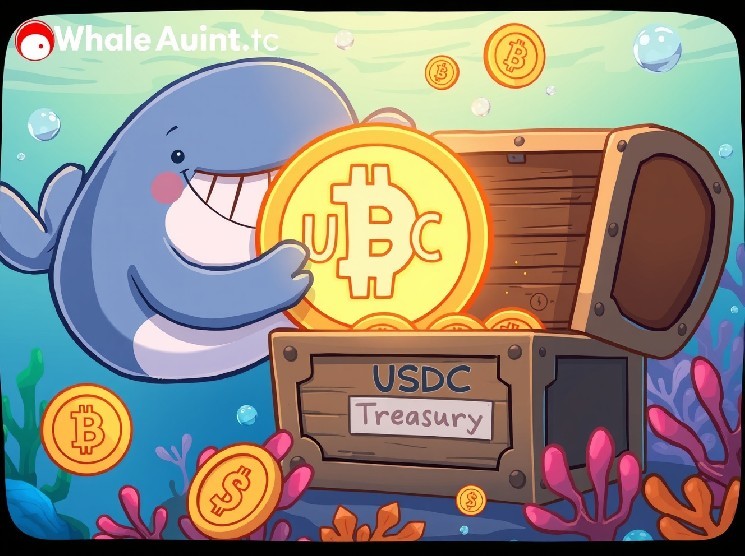Have you ever wondered what would happen if millions of dollars of stablecoins suddenly appeared in the cryptocurrency ecosystem? Whale Alert sent ripples through the crypto community when it reported that a whopping 250 million USDC was minted in the USDC Treasury. This significant event represents one of the largest stablecoin creations we have seen in recent times, and it is important to understand what this means for investors and the broader market.
Why was 250 million USDC minted?
The recent minting of 250 million USDC represents a significant injection of liquidity into the crypto ecosystem. When Circle, the company behind USDC, issues new tokens, it typically signals increased demand from institutional investors and exchanges that need additional stablecoin supply. This major USDC minting event signals several market developments.
- Increase in trading activity Across major cryptocurrency exchanges
- Growing interest from institutional investors In stablecoin based transactions
- potential preparation For large scale cryptocurrency purchases or investments
- Improving market liquidity For decentralized finance protocols
How does USDC minting actually work?
Understanding the process behind the creation of USDC helps explain why this 250 million USDC minting event is significant. If you want to get USDC, deposit your US dollars with Circle’s banking partners. The company will then create the same amount of USDC tokens on the blockchain. This process ensures that each USDC is fully backed by real US dollar reserves and maintains a 1:1 peg to the US dollar.
The recent USDC minted transactions were detected by Whale Alert, a popular blockchain tracking service that monitors large-scale cryptocurrency movements. Such large-scale minting activity often precedes significant market movements or signals increased confidence in stablecoin adoption.
What impact will the creation of a large-scale USDC have on the cryptocurrency market?
When 250 million USDC is injected into the market, there are some immediate effects that traders should monitor closely. This substantial USDC minting event typically indicates:
- Improving purchasing power For acquiring cryptocurrencies
- potential price support For major digital assets
- Enhancing DeFi liquidity Across lending and borrowing platforms
- Reduced volatility During large trading operations
Additionally, when we see large amounts of USDC being minted, it often indicates that major companies are positioning themselves for upcoming market activity. This could mean anything from organic accumulation to preparation for large-scale token launches and ecosystem development.
Should investors be concerned about stablecoin minting?
While large-scale stablecoin creation may seem alarming at first glance, the 250 million USDC minting event actually reflects healthy market dynamics. Stablecoins serve as the backbone of cryptocurrency trading and decentralized finance. As demand increases, supply must also expand accordingly to maintain market efficiency.
However, investors should always monitor these developments and consider the following:
- market timing Large-scale stablecoin injection
- Correlation with price movement In major virtual currencies
- overall market sentiment and trading volume
- Regulatory trends Affecting stablecoin operations
What does the future hold for USDC and stablecoins?
The consistent growth in USDC circulation, including this recent 250 million USDC mint transaction, demonstrates the growing importance of stablecoins in the digital asset ecosystem. As the adoption of cryptocurrencies grows, we can expect to see more frequent and large-scale stablecoin minting events to support increased trading volumes and DeFi activity.
Going forward, the evolution of stablecoins will focus on:
- Strengthening regulatory compliance and transparency
- Cross-chain interoperability Across multiple blockchain networks
- Improved yield Opportunity for holders
- Expanding use cases Beyond trading and DeFi
FAQ
What does it mean for USDC to be issued?
When USDC is minted, it means that new tokens are created and added to circulation. This occurs when a user deposits USD with a Circle partner, and equivalent USDC tokens are issued on the blockchain.
Is minting USDC good for the crypto market?
Yes, USDC minting generally shows increased demand and provides essential liquidity for trading and DeFi activities. This shows confidence in the stablecoin ecosystem and supports the overall health of the market.
How often do large USDC mints occur?
Large-scale USDC minting occurs periodically based on market demand. 250 million USDC is a significant amount, but as the stablecoin ecosystem grows, such events will occur multiple times each month.
Can anyone mint USDC tokens?
No, only authorized institutions can mint USDC directly through Circle’s regulated partners. Regular users obtain USDC through exchanges or by depositing dollars with approved entities.
Will minting USDC affect the price of cryptocurrencies?
Yes, large USDC minting events can impact prices by increasing available purchasing power and market liquidity. However, the impact will depend on the overall market situation and how the newly issued USDC is utilized.
Is my USDC safe after a major minting event?
Yes, USDC remains fully backed by dollar-denominated reserves, regardless of mintage. Each token maintains a 1:1 peg to the US dollar through transparent reserve management.
Share this insight with other crypto enthusiasts
Was this analysis of the 250 million USDC minting event helpful? Please share this article with your trading community and cryptocurrency enthusiasts. Help others understand how key trends in stablecoins are shaping market dynamics and creating new opportunities in the evolving digital asset landscape.
To learn more about the latest cryptocurrency trends, check out our article on key trends shaping stablecoin adoption and institutional investment strategies.
Disclaimer: The information provided does not constitute trading advice. Bitcoinworld.co.in takes no responsibility for investments made based on the information provided on this page. We strongly recommend independent research and consultation with qualified professionals before making any investment decisions.








